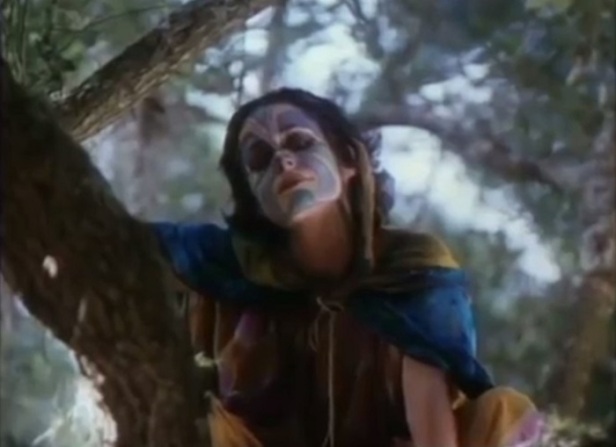Director Carter Lord took several years to make this obscure “folk horror” film – he started making it in 1979 but it wasn’t completed until 1983 and even then, it got only a very limited release, playing a few festivals, making sporadic appearances around the southern States before being sold off to CBS television who screened it under their CBS Movie of the Week umbrella. One can understand why it was a hard sell. a It’s slow-paced, rough edged, often poorly acted, very offbeat but rather haunting piece of freshly minted folklore that feels like it’s been based on the real thing. The author of the mythology was American poet and author Elizabeth Coatsworth. She gets no credit here, but the film is an adaptation of her 1951 novel The Enchanted: An Incredible Tale, the first of a quartet of “Incredible Tales” (the others were Silky: An Incredible Tale (1953), Mountain Bride: An Incredible Tale (1954) and The White Room: An Incredible Tale (1958)), all of them telling stories about the mysterious Perdrys family.
In Lord’s adaptation, the Perdrys are a strange family of almost ethereal, hippy/Amish hybrids who have turned up in the Florida back country. Here’s where the reclusive Booker T. Robertson (Julius Harris, the only professional actor in this cast) lives with his dog Pete (Scamp of Joshua Creek), eking out a living as a skilled hunter. When we first meet him, Booker gets a glimpse of the Perdrys before being reunited with Royce Hagen (Will Sennett), the son one of his old friends who died recently and recently returned, seemingly on a shim, from a life at sea. With Booker’s help, he starts restoring the abandoned old family home with a view to starting a cattle ranch and is happy to take up an offer of help from Pa (John Hallock) and Ma (Helen Blanton) Perdrys and their three daughters (Casey Blanton, Rhonda Mayhew and Sondra Mayhew), and two sons (Jerry Robison and Jimmy Robison). Booker is suspicious of the secretive family and their strange vegetarian ways, but they work hard, Royce is grateful for their help and besides, he’s starting falling for the oldest daughter, Twyla (Blanton). But there’s something very strange about the family – Booker warns that they’re a bit “too backwoods,” Twyla is terrified by a tiny cat and something is lurking in the surrounding woods slaughtering dogs and cattle. Could it have something to do with the local legend of “Hole in the Wall” (The Enchanted in the novel), a stretch of woods where a portal is said to exist between the human world and that of magical creatures…

In 1979, when work began on the film, memories of the appalling violence of August 1969, the murders committed by members of Charles Manson’s “Family” were still fresh in some people’s minds and the prospect of a group of strange, new-age hippie types in the deep South would probably have still struck terror in the minds of many. But the Perdrys turn out to be something very different – their hippie-like demeanour marks them as being out of time, but they’re actually out of this world, revealed at the end as birds who have taken human form for reasons not entirely clear (there’s a young woman who appears to be a werewolf on the loose too.) The inscrutability of the family lends The Enchanted much of its eeriness. There are clues as to their true nature scattered here and there – Twyla fainting when she sees a chicken that Royce brings home for dinner, and her sheer terror where she encounters a cat for example.
They seemed attuned to nature too and nature is ever-present, ever watchful and sometimes not a little menacing in this off the beaten track corner of the world. Animals watch and silently judge the humans around them, the film opens with a high shot that seems to take in the whole area that the story will play out in and storm clouds hover ominously on the horizons. It’s a place where Mankind seems unwelcome, a destructive force that offers little in return and where the humans struggle to cope against the forces of nature which are rarely overtly aggressive, but which always feels like they’re biding their time just outside the frame.

It’s a film with its problems though. The shaky performances of the supporting cast are often off-putting and Charné Porter’s editing sometimes feels “off”, too choppy, too eager to rush on to the next shot before we’ve had a chance to process the previous one. But there’s a lot to enjoy here too, not least the attractive photography of Michael Levine (he’d previously shot Bob Dylan’s Renaldo and Clara (1978) and went on to be an in-demand camera operator on Angel Heart (1987), Pulp Fiction (1994), Ghost World (2001) and many others) and a very nice synth score from Phil Sawyer that’s more ambitious than the usual hold-down-one-key-and-hope-for-the-best approach adopted on too many low budget 80s genre films.
And The Enchanted is most certainly not your run-of-the-mill 80s horror film. It might more accurately be labelled fantasy, but it fits neatly into the seemingly ever-growing canon of “folk horror” and only its relative obscurity has kept it from being more passionately embraced by the cognoscenti. Today it’s virtually forgotten – if it was ever that well known in the first place – but for all its faults is probably about right for re-discovery. It’s sense of foreboding is nicely sustained and pays off in one of the most head-scratching but fascinating, and certainly unforgettable, finales in any 80s genre film. The film has long been hard to find, though there was a time when the director himself was making if available on DVD via his website – the curious might want to see if he’s still willing to sell you a copy.